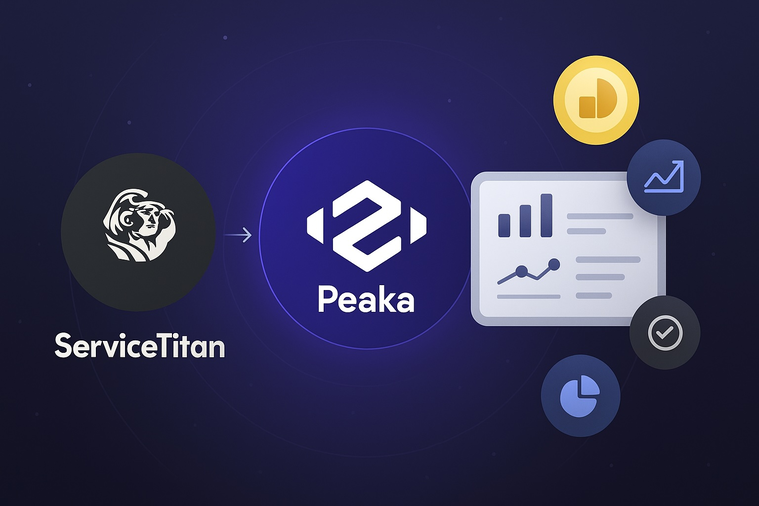The Contractor’s Dilemma: How to Replace Spreadsheets
If you run a home-service business with 50 to 500 employees, your data challenges have probably evolved faster than your tools. What once worked—a few spreadsheets, some manual exports from ServiceTitan or Sage Intacct, and a dashboard built by a helpful consultant—now feels painfully slow and brittle.
You’re managing multiple branches, juggling different systems, and tracking technician performance, job profitability, and backlog across locations. Every team wants real-time visibility, but your data lives in too many places to keep up.
The problem? You’ve outgrown spreadsheets, but Snowflake isn’t made for you either.
Key takeaways
-
Large contractors are stuck in a data gap: Their operations are too complex for spreadsheets, but too lean for enterprise-grade data stacks like Snowflake or Databricks.
-
Manual reporting doesn’t scale. As data grows across multiple ServiceTitan accounts and accounting systems, spreadsheet workflows hinder decision-making and create inconsistencies.
-
Building a traditional data stack isn’t practical. It requires high costs, technical expertise, and ongoing maintenance that most home-service businesses can’t afford.
-
Peaka offers a middle ground with data virtualization and ready-made connectors. Zero-ETL, zero-copy integrations connect ServiceTitan, accounting, and BI tools in real time, without the need for engineers or data warehouses.
The two extremes of the data spectrum
The spreadsheet trap
Spreadsheets and manual CSV exports were great when you had one office and a handful of techs. But as your operations scaled, the limits showed quickly:
-
Each report is a minefield of human error and security issues as it requires you to copy and paste data between files.
-
The manual cleanup and validation required is a time drain, which renders data outdated by the time it’s ready. And then there is the issue of metric definitions
-
Metrics are defined differently across different spreadsheets. No two “completed job” columns mean the same.
These errors compound across locations, costing hours of staff time and eroding trust in your reports.
The modern data stack mirage
At the other end of the spectrum lies the “modern data stack” consisting of tools like Snowflake, Databricks, dbt, and Airbyte that promise real-time integration, governance, and scalability.
They work beautifully if you’re an enterprise company with a full-time data team.
For most home-service contractors, this approach is overkill. The costs are daunting:
-
Cloud compute and storage fees can easily cost thousands of dollars per month.
-
Maintaining ETL pipelines, schemas, and permissions introduces new complexity, which can only be handled by a data team.
-
Data engineers and consultants command six-figure annual salaries.
For businesses whose margins depend on operational efficiency, this kind of overhead simply doesn’t make sense.
Why hiring a data team isn’t the answer
When the reporting workload becomes unbearable, many contractors consider hiring a data engineer or outsourcing to a BI consultant, thinking this will solve their data integration and reporting problems without having to invest in a data stack.
But even one full-time data engineer costs upward of $120,000 per year. It’s difficult to justify such an investment for a home service business when all these qualified people will be asked to do is build and maintain ETL pipelines, not generate insights.
An alternative is to call upon consultants. However, this often leads to automations managed by Zapier or Tray.ai that fail to cover different scenarios. If you opt for dashboards personally delivered by consultants, then you have to rely on static data that quickly goes stale when your data model changes.
The reality is simple: The home-service industry doesn’t need to mimic Silicon Valley’s data architecture. It needs something lighter, smarter, and built for operational agility—not engineering complexity.
The hidden costs of living between two worlds
Many fast-growing contractors end up stuck in the middle as they are too big for manual reporting but too lean for a data warehouse. The cost of being stuck in this no man’s land isn’t just financial; it’s operational.
-
Delayed insights: Revenue per technician or job-cost reports arrive days late.
-
Fragmented decision-making: Finance, operations, and branch managers each rely on their own spreadsheets.
-
Wasted expertise: Skilled managers spend hours cleaning data instead of analyzing it.
-
Reporting chaos: Different definitions and KPIs make cross-branch comparison impossible.
Without a unified, automated data layer, your “data strategy” becomes a patchwork of exports, Google Sheets, and one-off dashboards, none of which can keep up with how your business scales.
The middle path: Data virtualization, zero-ETL infra, zero-copy integrations
That’s where the next generation of data infrastructure comes into play. Instead of copying and moving data to a physical data warehouse, you can use a virtual layer that connects to your existing systems, such as ServiceTitan, QuickBooks, Sage Intacct, and others.
This approach, known as data virtualization, eliminates ETLs from the data integration process, removing the need for data teams that would be required to maintain brittle data pipelines. Data virtualization achieves the same results as a system built around data warehouses would, but without the astronomical cost and engineering overhead needed.
Peaka leverages this technique to turn your data scattered across multiple sources into virtual tables. It then provides a virtual data layer that defines your metrics (e.g., “revenue per technician,” “gross margin per job”) once and applies them everywhere. The result is real-time KPI dashboards that don’t depend on engineers or ETL scripts.
With Peaka, you can
-
Query data where it lives, instead of relying on manual CSV exports to unify it in a spreadsheet.
-
Create consistent KPIs across ServiceTitan and accounting systems.
-
Feed unified data directly into BI tools like Power BI or Looker Studio.
Contractors no longer have to invest in Snowflake or Databricks to integrate and make sense of its data integrate and make sense of their data, as Peaka gives them all the data stack they will ever need.
The future data infrastructure that contractors need
The next generation of home-service leaders will win not because they built massive data teams, but because they made data access simple, affordable, and fast.
AI-driven analytics and semantic-layer platforms are removing the need for traditional ETL. Instead of copying and moving data around, you define relationships once and let automation do the rest.
For large contractors, this shift changes everything:
-
Dashboards can be built in hours, not weeks.
-
Multi-location reporting becomes plug-and-play.
-
Business users can finally own their data workflows without relying on IT people.
The future of reporting in home services isn’t about data warehouses; it’s about connectivity and self-service business analytics for everyone.
Conclusion: Rethinking data readiness
Fast-growing contractors no longer have to choose between chaos and overkill. The middle path is here—one that helps integrate data from ServiceTitan and finance software and sends it to BI tools without replication or maintenance overhead.
If you’ve ever felt “too advanced for spreadsheets, too resource-constrained for Snowflake,” it’s time to rethink what data readiness means. You don’t need to rebuild a data stack; you just need to remove the friction between your systems.
Peaka is the middleware that will turn your existing systems into a cohesive reporting infrastructure.
Sign up to Peaka for free today.
Book a demo to see how Peaka helps top contractors save thousands of dollars in data integration costs every month.




 Please
fill out this field
Please
fill out this field













